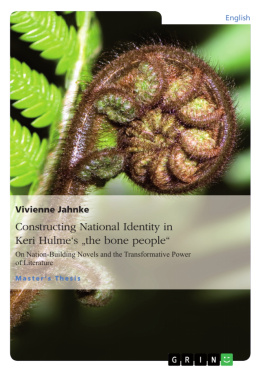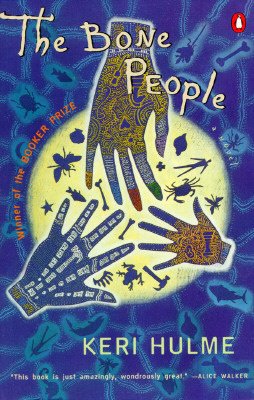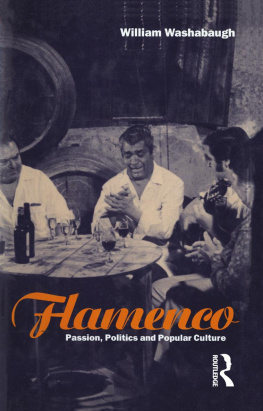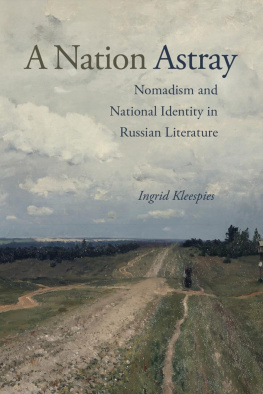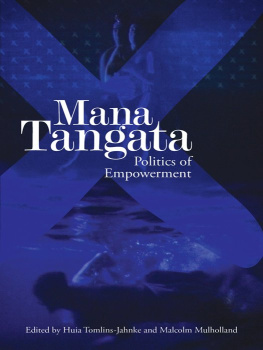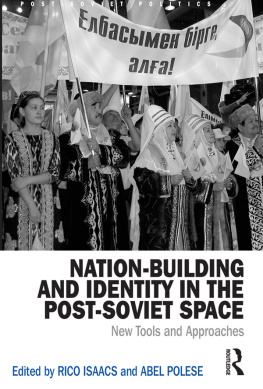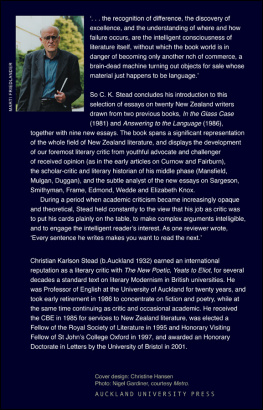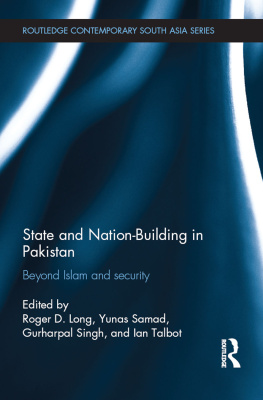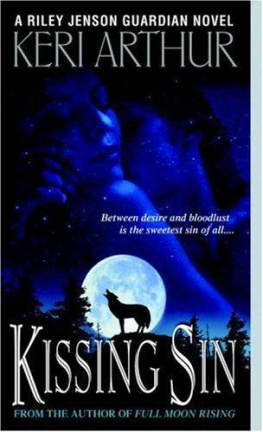Vivienne Jahnke - Constructing National Identity in Keri Hulmes the bone people: On Nation-Building Novels and the Transformative Power of Literature
Here you can read online Vivienne Jahnke - Constructing National Identity in Keri Hulmes the bone people: On Nation-Building Novels and the Transformative Power of Literature full text of the book (entire story) in english for free. Download pdf and epub, get meaning, cover and reviews about this ebook. year: 2015, publisher: GRIN Verlag, genre: Art. Description of the work, (preface) as well as reviews are available. Best literature library LitArk.com created for fans of good reading and offers a wide selection of genres:
Romance novel
Science fiction
Adventure
Detective
Science
History
Home and family
Prose
Art
Politics
Computer
Non-fiction
Religion
Business
Children
Humor
Choose a favorite category and find really read worthwhile books. Enjoy immersion in the world of imagination, feel the emotions of the characters or learn something new for yourself, make an fascinating discovery.
- Book:Constructing National Identity in Keri Hulmes the bone people: On Nation-Building Novels and the Transformative Power of Literature
- Author:
- Publisher:GRIN Verlag
- Genre:
- Year:2015
- Rating:4 / 5
- Favourites:Add to favourites
- Your mark:
- 80
- 1
- 2
- 3
- 4
- 5
Constructing National Identity in Keri Hulmes the bone people: On Nation-Building Novels and the Transformative Power of Literature: summary, description and annotation
We offer to read an annotation, description, summary or preface (depends on what the author of the book "Constructing National Identity in Keri Hulmes the bone people: On Nation-Building Novels and the Transformative Power of Literature" wrote himself). If you haven't found the necessary information about the book — write in the comments, we will try to find it.
Vivienne Jahnke: author's other books
Who wrote Constructing National Identity in Keri Hulmes the bone people: On Nation-Building Novels and the Transformative Power of Literature? Find out the surname, the name of the author of the book and a list of all author's works by series.
Constructing National Identity in Keri Hulmes the bone people: On Nation-Building Novels and the Transformative Power of Literature — read online for free the complete book (whole text) full work
Below is the text of the book, divided by pages. System saving the place of the last page read, allows you to conveniently read the book "Constructing National Identity in Keri Hulmes the bone people: On Nation-Building Novels and the Transformative Power of Literature" online for free, without having to search again every time where you left off. Put a bookmark, and you can go to the page where you finished reading at any time.
Font size:
Interval:
Bookmark:
Impressum:
Copyright (c) 2015 GRIN Verlag / Open Publishing GmbH, alle Inhalte urheberrechtlich geschtzt. Kopieren und verbreiten nur mit Genehmigung des Verlags.
Bei GRIN macht sich Ihr Wissen bezahlt! Wir verffentlichen kostenlos Ihre Haus-, Bachelor- und Masterarbeiten.
Jetzt bei www.grin.com hochladen und weltweit publizieren.
Table of Contents
Until recently, Maori writer Keri Hulme was the only New Zealand writer to have ever won the renowned Man Booker Prize. The Booker Prize is one of the highest honours to be awarded in the world of literature on an international scale. She won it in 1985 for her novel the bone people. Only in 2013, Hulme was succeeded by her fellow New Zealander, Eleanor Catton, for her historical mystery novel The Luminaries (Lyall). In the bone people, Hulme set out to create her very own New Zealand myth. She has stated that she wanted the novel to harmonise her countrys two major cultural influences, New Zealand being home to the indigenous Maori as well as the European-descendant Pakeha (Contemporary Literary Criticism 158). Hulme herself embodies this approach to identity, as she is of both Maori and European descent. Despite biologically being only an eighth Maori, she consciously chooses to identify with this part of her heritage without neglecting to honour her European heritage where due (Fee 53; Peek 3). In accordance with her mission statement, in her novel Hulme carefully constructs a vision of a New Zealand society which can only fully function with Pakeha and Maori living together in unison, her three protagonists serving as metaphorical stand-ins signifying the mixture of cultures present in New Zealand. Crucially, however, her notion of an ideal New Zealand society is one fundamentally shaped by Maori spirituality and community, appointing a predominant role to Maori culture for the whole of society. This differs significantly from the reality of 1980s New Zealand, where Pakeha culture dominated every aspect of society, and it was solely the Maori who had to try to fit in with the Pakeha way of life.
New Zealand having first been discovered around 1350 by the group of Polynesians who were later designated Maori by the European settlers, the first European contact took place only in 1642, when Dutch explorer Abel Tasman discovered the islands and named them Nieuw Zeeland, after a province in his home country. Almost a century later, James Cook rediscovered the islands in 1769, eventually claiming them for the British Empire (Stachurski xii-xiii). This occupation was later consolidated in 1840 in the Treaty of Waitangi, which granted the right to govern New Zealand to the British monarchs and equal citizen rights to the Maori at least on paper. In reality, within the imperialistic paradigm of the time, Maori were never fully equal in a country now governed by the white settlers. Maori culture was exposed to imperialist ideology, the consequences being a gradual but inevitable suppression of their traditional way of life. Yet connected to the Treaty of Waitangi, New Zealands much-debated founding document, is the notion that with its signing Europeans and Maori became one people. This myth of a nation defined by one culture served the Europeans in justifying their presence in the country, as well as their practice of cultural imperialism, operating under the notion that the Maori could only benefit from being exposed to Western culture. Furthermore, the myth later supported the Europeans in developing an identity independent from Great Britain (Williams, New Zealand Nationalisms 21-22).
Up until the Second World War, the Europeans in New Zealand did not question the legitimacy of the cultural and racial hierarchy in their country. However, the transition from a colonial into a postcolonial state during the second half of the twentieth century meant that the country was forced to re-visit this dynamic and, with the ties to Europe gradually loosening, confront their colonial legacy. This also opened up new space for the Maori to make their grievances heard, taking to the streets to raise public awareness of the discriminations they had suffered and the institutionalised racism present in the country. It also resulted in the Maori Renaissance, a movement on the rise during the second half of the twentieth century, where Maori strongly pursued their goal of revitalising Maori culture (Stachurski 40). This was expressed through political protests, but also through art. As a result, the Maori language, Te Reo Maori, was granted the status of an official language next to English and a tribunal for settling claims and reimbursing Maori for their losses of land since the Treaty of Waitangi was instated (Derby). On a political level, the official policy from one of assimilation and integration of Maori into the dominant Pakeha culture was changed to the policy still officially advocated in New Zealand today, a policy of biculturalism, attempting to give both cultures equal room to exist alongside each other (Derby). The change of governmental policy together with the many movements to acknowledge the presence of Maori culture in the 1980s resulted in a palpable feeling that fundamental change was actually possible. Things were seemingly looking up again from the viewpoint of the Maori in New Zealand.
Hulmes novel with its optimistic approach to the future of New Zealand society clearly is a product of this time and indeed it is the product of almost two decades of work. Before becoming a writer, Hulme studied Law at Canterbury University, but dropped out of the degree, and after working a row of odd-jobs she moved to the west coast of New Zealands South Island in 1973 upon realising that being a writer was her true calling (OMeagher 14; Ross and Stone 209). As she puts it humorously, she retired at the age of twenty-five (Ricketts 22). In order to be able to live off her earnings as a writer, Hulme had the luck of availing herself of diverse financial support, being granted several scholarships, grants and awards throughout her career (Long, Conversation with Keri Hulme 4). Apart from the aforementioned Booker she won all of New Zealands major awards for literature from the Book of the Year Award to the Mobil Pegasus Award for Maori Literature for the bone people (Ross and Stone 209).
Before finally publishing the latter, Hulme was known to New Zealanders primarily as a writer of short stories and poetry. The works published around the time of the bone people, such as the poems assembled in The Silences Between (Moeraki Conversations) (published in 1982), or her short story collection Te Kaihau/The Windeater (published 1986), seem like companions to her major work, all overshadowed by her achievement of the bone people. In part this is due to the fact that many of her stories and poems stem from the writing or editing time of the bone people. Additionally, the themes salient in the bone people, such as her bicultural agenda, postcolonial identity, the relationship between New Zealanders and the land they live on, spirituality, as well as characters marked by their position outside the established dominant norms of society, are elaborated on further in her other works.
The bone people began its life in 1966, with a dream Hulme had at the age of eighteen which then led to a short story entitled Simon Peters Shell (Hulme, Standards in a Non-Standard Book: xii; Turcotte 137). Over almost two decades, the novel changed its form constantly, shaped by the real events that shook the nations identity, until it finally evolved into what is known today as the bone people. The story is set on the rugged west coast of New Zealands South Island, a setting the author is very familiar with as she has been residing there herself for several decades now. Three main protagonists make up the backbone of the novel. One day, Kerewin Holmes (as the author confirms, a bad pun on her own name [Turcotte 137]), a reclusive artist of mixed Maori and Pakeha descent, stumbles upon a small Pakeha boy, Simon, in her isolated tower home. She soon finds out that the boy is mute as well as prone to mischief and that he lives with his Maori foster father, Joe Gillaley. His foster father took him into his home after Simon solely survived a shipwreck off New Zealands rugged coast. The three protagonists build an alternative family unit, seemingly unable to let go of each other after a reluctant start. The idyll comes to an end when Kerewin, having chosen before to put aside her nagging suspicion that something is terribly wrong with her two acquaintances, finds out that Joe has been severely abusing his son, Simons scars bearing witness to the repeated beatings his father has been inflicting on him. As Simon has, despite her best efforts, become close to her heart, Kerewin decides to protect him from further harm by taking matters into her own hands. Eventually, this backfires as her temper unleashes a final beating on Simon which leads him to the hospital, now not only mute but also partially deaf, and Joe to a stint in prison. Thereafter, each of the characters goes on a quest in order to overcome their respective crises and be able to finally reconnect with each other and form a kind of idealised
Font size:
Interval:
Bookmark:
Similar books «Constructing National Identity in Keri Hulmes the bone people: On Nation-Building Novels and the Transformative Power of Literature»
Look at similar books to Constructing National Identity in Keri Hulmes the bone people: On Nation-Building Novels and the Transformative Power of Literature. We have selected literature similar in name and meaning in the hope of providing readers with more options to find new, interesting, not yet read works.
Discussion, reviews of the book Constructing National Identity in Keri Hulmes the bone people: On Nation-Building Novels and the Transformative Power of Literature and just readers' own opinions. Leave your comments, write what you think about the work, its meaning or the main characters. Specify what exactly you liked and what you didn't like, and why you think so.

